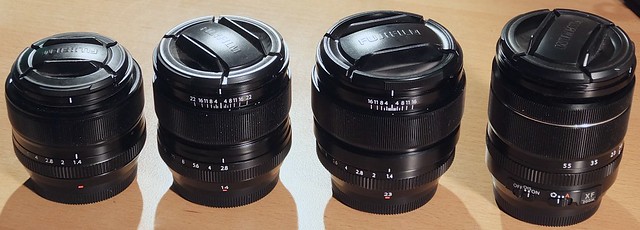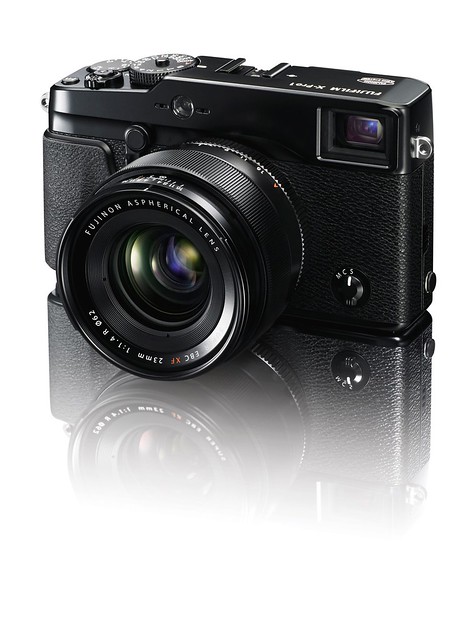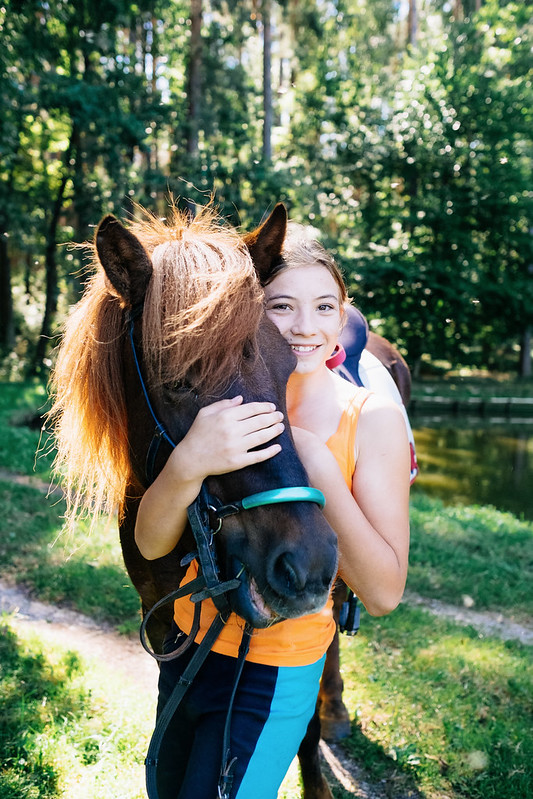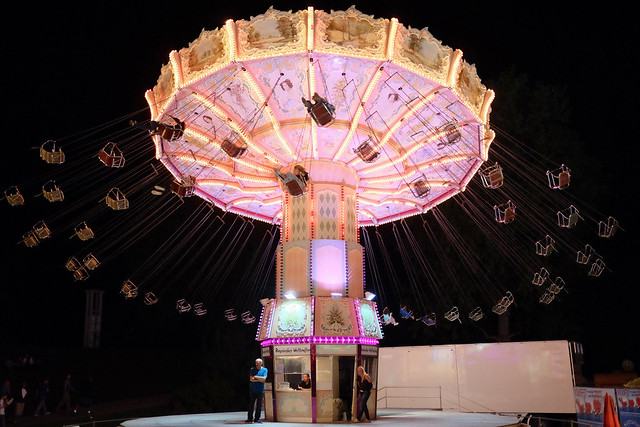First Look: Fujinon XF23mmF1.4 R
Talk to Rico (open forum for questions & feedback) – Rico’s Flickr sets – XF23mmF1.4 samples set – Mastering the Fujifilm X-Pro1 reading samples (65 free pages) – Pre-order the new book: Mastering the Fujifilm X-E1 and X-Pro1
Flickr bravely chose Friday the 13th for a major maintenance downtime, but they were back online with a delay of just one hour. Hoping for the best, I got things started with this column, but then Flickr was forced shut down again (well, what did they expect?), causing more delays. And yet, here we finally are, discussing Fuji’s latest XF prime, the fast and quite substantial XF23mmF1.4 R, a much sought-after “35mm equivalent” lens.
If you are interested in this lens, you might also want to have a look at my previous article about using the XF14mmF2.8 R wide-angle lens. Conceptually, both lenses are quite similar:
- they offer premium optics and build quality at a premium price
- they feature a dedicated manual focus mode with analog (engraved) scales indicating distance and depth-of-field
- distortion is fully optically corrected (no additional digital distortion correction necessary)
Size and Specifications
Given these similarities, it’s no surprise that the new 23mm and the older 14mm lens now share a common owner’s manual. The following rendering displays the 23mm lens in its full manual focus mode glory:

While Fuji’s recently released XF27mmF2.8 Pancake prime is optimized for minimum size and weight, the new 23mm is a much bulkier affair, especially if you choose to attach the included butterfly-style lens hood. Here’s my pre-production lens on an X-M1 next to an X100S with similar configuration (the X100S features the same 23mm focal length, but one stop slower):

As you can see, I attached the optional handgrip to my X-M1. To me, the grip is a major improvement.
In case you haven’t read the specs of the new lens, please click here to look at them on Fujifilm’s official global site.
At 300 grams, this prime is a bit on the heavy side compared to its XF prime siblings, but it is still lightweight and compact when compared to many of its “full-frame” counterparts. Here’s the new lens next to Fuji’s 35mm and 14mm XF primes as well as last year’s 18-55mm XF “kit” zoom lens:

As it appears, the size difference isn’t that big if you omit the lens hoods. That shouldn’t be a problem in most situations, since the new XF23mmF1.4 R features the same flare-resistant HT Super EBC coating as the hoodless 27mm pancake lens.
Sticking with the specs for a moment, here’s what else may be important:
- rounded seven-blade diaphragm
- fast internal focussing using a high-torque DC coreless motor (similar to the XF14mmF2.8 R)
- the focusing lens group consists of three cemented lens elements and one aspheric lens element
- 62mm filter thread (same as in the 55-200mm tele zoom)
- 28cm minimum focussing distance
- dedicated manual focus mode with engraved distance and DOF scales (operation is still focus-by-wire, though)
- distortion is fully optically corrected, vignetting is addressed digitally trough RAW file metadata
Build Quality
As you would expect from a lens in this (price) category, the XF23mm is solidly built and features a dedicated aperture ring. The stops “click” smoothly in place in 1/3 EV intervals. Compared to the XF14mm lens, the aperture ring’s torque (especially at its wide open setting) has been increased, making it harder to accidentally change the aperture setting.
In order to enter manual focus mode, the focus ring can be shifted back, revealing analog distance and depth-of-field scales. As is the case with the 14mm lens, the engraved DOF readings are less conservative (and hence more suitable to most practical minded shooters) than the digital readings in the camera. To avoid conflicts and user confusion, all digital distance and DOF measurement readings are disabled once manual focus has been activated.
The substantial build of the lens barrel is counteracted by a butterfly-shaped plastic lens hood. As effective as the hood may be, it doesn’t really match the classic design of the lens (or of the cameras it is supposed to be attached on).
Using the Lens
The XF23mm lens is compatible with all current (and future) APS-C sensor X-Mount camera models. There’s no requirement to update the firmware of your camera (as long as it’s the current version), just mount the lens and start shooting.

Users of the X-Pro1 will be pleased to hear that the lens is fully supported by the camera’s dual-view OVF. With any focal length below 35mm, the X-Pro1 will automatically set the OVF to its wider magnification view. In this setting, the lens barrel obscures only a small part of the superimposed bright frame, even when the lens hood is attached.
Autofocus feels quite snappy, and while its operation isn’t completely silent, I didn’t find the sounds to be distracting. If you have experience with the XF14mm sibling of this lens, you pretty much already know what to expect.
To me, the pseudo-analog manual focus operation of the lens is a mixed bag. I certainly appreciate analog scales and a focus ring with hard stops at each end, even though the actual operation is still focus-by-wire. However, I am not convinced by Fuji’s choice to disable all digital distance and DOF indicactors once manual focus has been activated either on the camera or on the lens.
For starters, it’s hard to read the engraved DOF and distance markings in the dark, which contradicts using a fast lens that (according to Fuji’s own press release) is meant to be suitable for night time shooting. Even worse, you have to choose between One-Touch-AF (= focussing by pressing the AF-L button) and using the manual focus ring. You can’t have both at the same time, so it’s not possible to use One-Touch-AF to quickly acquire focus and then fine-tune your result with the focus ring.
Granted, the XF14mm lens suffers from the same handicap, but that doesn’t make things any better, does it? Besides: Since One-Touch-AF is only available with the camera in MF and the lens in AF mode, this configuration takes away all analog and digital distance/DOF readings. With One-Touch-AF, you are literally shooting in the dark, with no indication of distance and depth-of-field, neither analog nor digital.
On a brighter note, focus peaking works quite well thanks to the XF23mm’s large maximum aperture opening. As you probably know, manual focus always operates at maximum aperture, and the shallow depth-of-field of a wide open lens is of great help during manual focus acquisition.
In autofocus mode, the lens works and behaves like all the other Fuji XF/XC lenses, so no worries here.
Image Quality
Shooting a pre-production lens with beta firmware means using an unfinished product. Up to 25 percent of the used parts can differ between Fuji’s pre-production and production products. Right after I had finished shooting my set of 50 samples, I received a firmware update for the lens, reminding me of the work-in-progress nature of it all. So please refrain from pixel peeping and reaching final verdicts based on what’s available at this time. In any case, it’s safe to assume that production lenses will either on par or even better than my current pre-production sample.
Personally, I was quite pleased with the results, but that’s irrelevant. Have a look at the samples and make op your own mind! I shot in all kinds of light with a broad variety of apertures and object distances, utilizing the full 200-6400 ISO range of my (still pre-production) X-M1. Some of the samples are SOOC JPEGs, some are JPEGs with just minor corrections, and there also JPEGs with some color work performed in Apple Aperture. In addition to that, I have included several samples that were processed as RAWs in Lightroom and Silkypix 5, and some samples are in black and white. In any case, each image contains a brief description telling you about what, if any, processing was used. Again, click here to see the complete sample images gallery.
Thank you, everybody, for an interesting week. Next Tuesday (17SEP), I will bring you an X-Pert corner special edition covering a new X-Mount camera I have personally grown quite fond of in the past weeks testing it. See you then, and have a nice weekend!
Pre-orders
USA: AmazonUS / BHphoto / Adorama / Pictureline EUROPE: PCHstore / wexcamerasDE / wexphotographicUK
For your convenience, here’s a TOC with links to my previous X-PERT CORNER articles:
- RAW Converter Shootout Results
- Ultimate RAW Converter Shootout
- First Look: X-M1 with New Kit Zoom and Pancake Lens
- Zeiss Touit vs. Fujinon XF
- Remote Shutter Control for X Series Cameras
- Apple Camera RAW, X-Trans and EXR
- First Look: XF55-200mmF3.5-4.8 R LM OIS
- Studio X
- Using the X100S
- Using the X20
- X100S vs. X100
- X20 vs. X10
- RAW, JPEG, Silkypix and “Fuji Colors”
- Adapting Third-Party Lenses (updated with Speed Booster)
- RAW for JPEG Shooters…
- Tips for Updating your Firmware
- How to Clean the X-Trans Sensor
- Using the XF14mmF2.8 R
- Decoding XF18-55mmF2.8-4 R LM OIS
- Comparing RAW converters: JPEG vs. Lightroom, Capture One, Silkypix & RPP
- XF14mmF2.8 R appears to be almost distortion free
- How to Expand Dynamic Range
- How to Use Extended ISO
- EXR, anyone?
- Capture One – When the Going Gets Tough…
- Using Shooting Profiles and the Quick Menu
Rico Pfirstinger studied communications and has been working as journalist, publicist, and photographer since the mid-80s. He has written a number of books on topics as diverse as Adobe PageMaker and sled dogs, and produced a beautiful book of photographs titled Huskies in Action (German version). He has spent time working as the head of a department with the German Burda-Publishing Company and served as chief editor for a winter sports website. After eight years as a freelance film critic and entertainment writer in Los Angeles, Rico now lives in Germany and devotes his time to digital photography and compact camera systems. His book “Mastering the FUJIFILM X-Pro1” (Kindle Edition) (Apple iBook Store) (German version) is available on Amazon and offers a plethora of tips, secrets and background information on successfully using Fuji’s X-Pro1 and X-E1 system cameras, lenses and key accessories.















